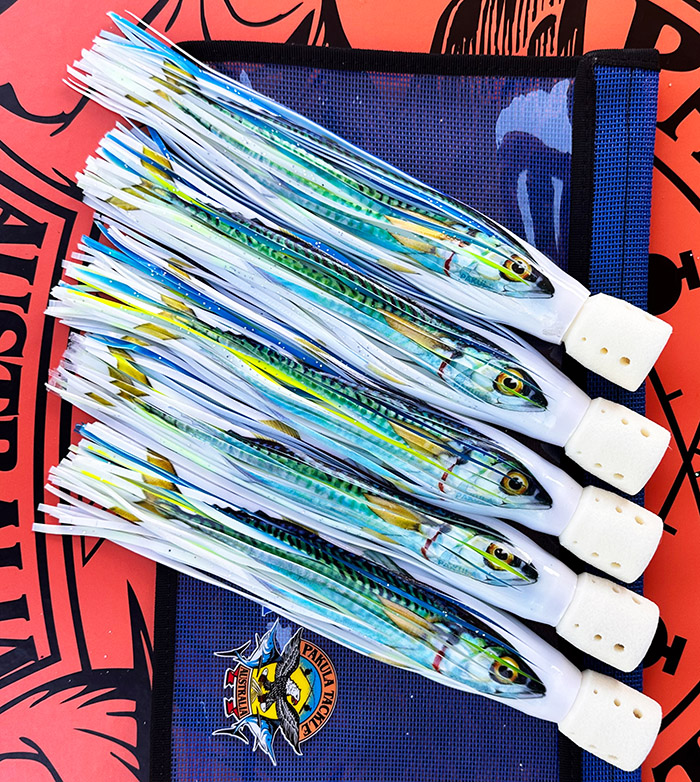What the Heck is Sympathetic Vibration?
How understanding it can help us target more fish.
Peter Pakula 23rd August 2024. (Draft Part 1 of 2)

We’re very good at assuming we can make great choices when choosing lures simply by their look or by a mate's recommendations. Humans love pretty little trinkets. Our main sense is that of eyesight, so we wrongly assume that it’s the most important to everything else, including our target fish species.
Though eyesight is certainly important, it’s not the only sense that fish have at their disposal. As important if not more important to consider is the lateral line which all fish have. It’s an enormous organ that runs for the full length of its body and senses vibrations from all directions in its 3D world. Marlins also have very sensitive inner ears that also feel vibrations from a great distance. It’s worth looking up scientific papers on the biology of your target species to appreciate that our thinking of the way we target them hasn’t been very as effective as it could be.
Fish’s Lateral Line:
Here are some key points about its sensitivity:
- Detection of Low-Frequency Vibrations: The lateral line is most sensitive to low-frequency vibrations, typically between 10 to 200 Hz. This range is ideal for detecting movements like the swimming of other fish, the approach of a predator, or even the flow of water around objects.
- Sensitivity to Pressure Changes: Fish can detect changes in water pressure as small as a few millimetres. This allows them to sense the presence of objects and other fish even in complete darkness or murky water, where vision is limited.
- Directional Awareness: The lateral line is highly directional, meaning it can help a fish determine the exact location of a vibration source. This is particularly useful in predator-prey interactions, as it allows fish to quickly respond to the movements of nearby creatures.
- Environmental Adaptation: In some species, the sensitivity of the lateral line can adapt to different environments. For example, fish that live in fast-flowing streams may have a more sensitive lateral line to detect the flow of water, while those in still waters may be more attuned to detecting the movement of other fish.
Overall, the lateral line is a finely tuned sensory system that provides fish with detailed information about their surroundings, helping them to navigate, hunt, and avoid danger with remarkable precision.
Sympathetic vibrations simple explanation
Sympathetic Vibration is when an object starts to vibrate because it "feels" the vibrations from another object nearby. This happens when the two objects share the same natural frequency.
For example, if you play a certain note on a piano, and there's a guitar nearby with a string that matches that note, the guitar string might start vibrating on its own, even though you didn't touch it. The vibrations from the piano travelled through the air and caused the guitar strings to vibrate because they were "in tune" with each other.
In simple terms, it's like when something "catches" vibrations from something else because they're naturally tuned to respond to those vibrations.
Sympathetic Vibration concerning fish behaviour
Sympathetic vibration, also known as resonance, occurs when an object or system vibrates in response to an external vibration at a particular frequency. In the context of fish behaviour, sympathetic vibration can be related to how fish detect and respond to vibrations or sound waves in their environment.
Sympathetic Vibration and Fish Behaviour:
- Lateral Line System: Fish have a specialized sensory system called the lateral line, which runs along the sides of their bodies. This system detects water movements and vibrations, allowing fish to sense nearby objects, predators, prey, or other fish. Sympathetic vibration can play a role when external vibrations match the natural frequencies that the lateral line is tuned to, enhancing the fish's ability to detect specific movements in the water.
- Communication: Some fish produce sounds or vibrations to communicate with each other, especially during mating rituals or territorial disputes. These sounds can cause sympathetic vibrations in the water, which other fish detect. Fish may respond to these vibrations by adjusting their behaviour, such as moving closer to or away from the source of the sound.
- Predator and Prey Interactions: Predatory fish can detect the vibrations caused by the movement of prey. Sympathetic vibration enhances the ability of predatory fish to locate their prey, particularly when the prey's movements cause vibrations that resonate with the predator's sensory systems.
- Schooling Behaviour: Fish often swim in schools, where they can detect the movements of nearby fish through the vibrations transmitted through the water. Sympathetic vibration can help synchronize the movements of fish within a school, enabling them to move as a cohesive unit and avoid predators more effectively.
- Environmental Influences: Human activities, such as boat engines or underwater construction, can generate vibrations that might affect fish behaviour. If these vibrations resonate with the frequencies that fish are sensitive to, they could disrupt normal behaviour patterns, leading to stress, disorientation, or changes in habitat use.
In summary, sympathetic vibration plays a significant role in how fish perceive and respond to their environment, influencing communication, predator-prey interactions, and social behaviours like schooling.
Is the volume increased more in two similar objects than in two separate objects?
When two similar objects vibrate sympathetically at the same frequency, the resulting volume (or sound intensity) can indeed be louder compared to two separate objects vibrating independently at different frequencies.
Here's why:
- Constructive Interference:
- o When two objects vibrate at the same frequency and are in phase (their vibrations align), their sound waves can combine through a process called constructive interference. This means the peaks and troughs of the sound waves from both objects add together, resulting in a louder sound.
- Resonance:
- o Similar objects that share the same natural frequency can resonate with each other, amplifying the vibrations. This resonance can cause the vibrations to become stronger, leading to an increase in the sound volume. The objects effectively reinforce each other’s vibrations.
- Energy Transfer:
- o When one object vibrates and another similar object vibrates sympathetically, energy is efficiently transferred between them. This energy transfer can sustain or even increase the amplitude of the vibrations, contributing to a louder sound.
In contrast, when two separate objects with different frequencies vibrate:
- Lack of Resonance: The vibrations do not resonate with each other, so there is no amplification of sound. Each object vibrates independently, and its sound waves may not align in a way that increases volume.
- Possible Destructive Interference: If the sound waves from the two objects are out of phase (the peaks of one wave align with the troughs of another), they can partially cancel each other out, reducing the overall sound volume.
Summary:
Two similar objects vibrating sympathetically at the same frequency can produce a louder sound due to resonance and constructive interference. In contrast, two separate objects with different frequencies are less likely to experience these effects, so their combined volume will not be as high.
A cool example of Sympathetic Vibration:
Why does a series of metronomes have sympathetic vibration?
Sympathetic Vibrations in a series of metronomes occur due to the phenomenon of coupled oscillation. Here's how it works:
- Coupling Mechanism: When multiple metronomes are placed on a common movable platform (like a table or a board that can move slightly), they become mechanically coupled. This platform can move back and forth in response to the oscillations of the metronomes.
- Energy Transfer: As each metronome ticks, it exerts a small force on the platform. If one metronome is out of sync with the others, the force it exerts can slightly move the platform. This movement can then influence the other metronomes.
- Synchronization: Over time, the energy transfer between the metronomes through the moving platform leads to synchronization. The metronomes will gradually fall into the same rhythm or phase because it minimizes the overall energy in the system. The oscillations of the platform reinforce the oscillations of the metronomes that are in sync and dampen those that are not, leading them to adjust their timing.
- Sympathetic Vibrations: The phenomenon of sympathetic vibrations occurs as the metronomes influence each other through their shared platform, leading them to vibrate at the same frequency or in a synchronized manner.
This is a classic example of how coupled oscillators, even if they start with different phases or frequencies, can spontaneously synchronize over time due to the interactions between them.
Check out this video:
Five metronomes are set to 176 bpm and placed on a Foam Core board. When empty cans are placed underneath, the board is free to move from side to side and the metronomes can influence each other into synchronization. When the cans are removed the metronomes are no longer physically coupled and some of them begin to fall out of step. Our demonstration is a copy of one that Bryan Daniels (Ohio Wesleyan University) made for his student research work:
For more details on our setup see: http://sciencedemonstrations.fas.harv...
Video: https://www.youtube.com/watch?v=Aaxw4zbULMs&t=4s
How all this relates to lure choice:
After many years trolling lures for gamefish on the deep blue ocean for pelagics, Bass and Barra in impoundments and even Flathead in the Gold Coast Broadwater you remember some incredible days when we caught so many more fish than anyone else, often consistently over many seasons, sometimes on just a few days. Was it just a bunch of lucky days or was there more to it? Did we do anything different on those days that we didn’t do on other days?
In hindsight, yes, we did.
A few examples:
- The day fishing for Bass with Chris Hall on Hinze Dam we caught around 90 Bass in a single morning. We trolled 4 identical lures.
- Trolling for Flathead in the Gold Coast Broadwater: We trolled all Mans Stretch 25, all Mans Stretch 30’s or All Long A deep Bombers depending on the depth of the trolling run. We caught lots more than anyone else for several seasons.
- Gold Coast Grand Slam 2002 we caught 7 Black Marlin in a day in a tournament where the next best boat caught 1 even though we were fishing amongst many other of the 28 other boats in the tournament. This happened a few days over the next few years.
At Pakula Tackle we’ve been developing lure patterns ie lures that work together to give you great results. During a recent hospital stay, I had a lousy internet connection and found myself looking at a bunch of old raw uncut video clips of our gamefishing days. A comment made during one of them during the Grand Slam Tournament was “All the lures are breathing at the same time, how cool is that!”
It seems without knowing it at the time, we may have been running lures that were in Sympathetic Vibration, or more accurately Sympathetic Resonance, so we may have been calling in fish from a greater distance than others were.
In all of our previous 5 lure patterns, we have two or three identical heads in different colours which has worked well. With adjustment, those identical lures may work in Sympathetic Resonance.
Our most recent release of the Hailey’s Comets lures has certainly been very successful, perhaps they do fit into having Sympathetic Resonance though you’ll likely have to adjust them on the face of pressure waves to get them all breathing at the same time.
Remember, you read it here first.
Further reading: https://www.marlinmag.com/story/howto/billfish-hearing-science/





